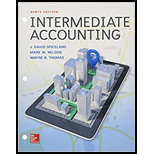
Concept explainers
(1)
Financial Statements: Financial statements are condensed summary of transactions communicated in the form of reports for the purpose of decision making. The financial statements reports, and shows the financial status of the business. The financial statements consist of the
Financial Disclosures: Financial disclosures refer to all material, significant and relevant information about the reporting organization that are essential to understand the financial statements of the organization entirely. It also helps to evaluate the performance and the financial health of an organization. These disclosures are either provided on the face of the financial statement or as notes to the financial statements as supporting schedules.
GAAP:
Generally Accepted Accounting Principle (GAAP) is a common set of accounting principles, standards, and procedures that the companies must follow at the time of preparation of the financial statements.
IFRS:
International Financial Reporting Standard is abbreviated as IFRS. The IFRS is set up to bring a standard global language in accounting, so that the other firms across the globe can understand the accounting term of all other businesses.
Rules of Debit and Credit:
Following rules are followed for debiting and crediting different accounts while they occur in business transactions:
- Debit all increase in assets, expenses and dividends, all decrease in liabilities, revenues and stockholders’ equities.
- Credit all increase in liabilities, revenues, and stockholders’ equities, and all decrease in assets and expenses.
To determine: The reason for increase in total deferred income of €249 as of the end of fiscal 2015. \
(2)
To explain: the threshold for recognition of provision under IFRS different than it is under U.S. GAAP.
(3)(a)
Beginning and ending balances of total provisions and retirement benefits shown in Note 32 for fiscal 2015 tie to the balance sheet.
b.
To prepare:
(4)
To know: Whether amounts of
Want to see the full answer?
Check out a sample textbook solution
Chapter 13 Solutions
INTERMEDIATE ACCOUNTING(LL)-W/CONNECT
- ✓ Unit Price $12.51 $35.39 $34.98 $12.13 $43.98 A B D E F G H K 1 Product Order Quantity ✓ Product ID ✓ Unit Price Gross Sales Formulas for Columns C, D, & E Product Product ID 2 Carry-on Suitcase 3 Carry-on Suitcase 4 Bluetooth Headphones 5 Carry-on Suitcase 6 Travel Pillow 7 Travel Umbrella 8 Battery Pack 9 Travel Pillow 10 Travel Pillow 11 Battery Pack 12 Battery Pack 13 Travel Pillow 14 Bluetooth Headphones 15 Battery Pack 16 Bluetooth Headphones 17 Travel Umbrella 18 Carry-on Suitcase 19 Bluetooth Headphones 20 Travel Umbrella 21 Bluetooth Headphones 22 Travel Umbrella 23 #N/A #N/A #N/A Travel Umbrella B07NQKQ19S #N/A #N/A #N/A Bluetooth Headphones B01NAJGGA2 10 #N/A #N/A #N/A Battery Pack B00Z9QVE4Q 9 23 27 27 23 6 1 #N/A #N/A #N/A Travel Pillow B00GXBZM5I #N/A #N/A #N/A Carry-on Suitcase B07PB3P1N8 #N/A #N/A #N/A #N/A #N/A #N/A Pivot Table #N/A #N/A #N/A #N/A #N/A #N/A #N/A #N/A #N/A 19 23 Battery Pack 25 24 Bluetooth Headphones 25 Carry-on Suitcase 26 Travel Pillow 27 Battery…arrow_forwardA company sold a piece of equipment that originally cost $55,000 for $20,000 when accumulated depreciation on the equipment was $40,000. What is the amount of gain or loss recorded on the sale of this equipment?arrow_forwardFinancial Accounting Questionarrow_forward
- Can you help me solve this general accounting problem with the correct methodology?arrow_forwardOn August 31, 20X1, the balance in the checkbook and the Cash account of the Dry Creek Bed and Breakfast was $12,831. The balance shown on the bank statement on the same date was $13,677. Notes a. The firm's records indicate that a $1,700 deposit dated August 30 and a $701 deposit dated August 31 do not appear on the bank statement. b. A service charge of $35 and a debit memorandum of $250 covering an NSF check have not yet been entered in the firm's records. (The check was issued by Andrew Corollo, a credit customer) c. The following checks were issued but have not yet been paid by the bank Check 712, Check 713, Check 716, $125 $ 130 $ 245 Check 736, $ 577 Check 739, Check 741, $187 $ 118 d. A credit memorandum shows that the bank collected a $2,095 note receivable and interest of $55 for the firm. These amounts have not yet been entered in the firm's records. Required: 1. Prepare a bank reconciliation statement for the firm as of August 31. 2. Record general journal entries for items…arrow_forwardI need help finding the correct solution to this financial accounting problem with valid methods.arrow_forward
- Please show me the correct approach to solving this financial accounting question with proper techniques.arrow_forwardI am trying to find the accurate solution to this general accounting problem with appropriate explanations.arrow_forwardCould you explain the steps for solving this financial accounting question accurately?arrow_forward
 Survey of Accounting (Accounting I)AccountingISBN:9781305961883Author:Carl WarrenPublisher:Cengage Learning
Survey of Accounting (Accounting I)AccountingISBN:9781305961883Author:Carl WarrenPublisher:Cengage Learning
